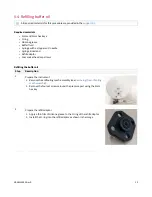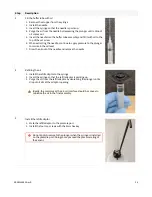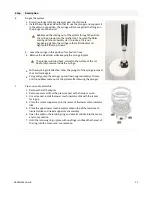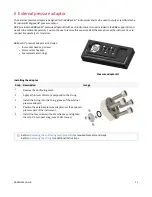
RBR#0008818revB
21
•
•
•
•
•
•
5.2 Filling the syringe and de-gassing the buffer oil
It is important to remove all gases from the system as they can form bubbles and cause anomalies in the data. Refill the
system with de-gassed oil any time when cleaning it, or if it has had an oil leak for any reason.
Required materials
Buffer fluid
Syringe with a stopper and needle
Syringe kickstand
Recommended handling materials
Latex or nitrile gloves
Lint-free tissues
Protective coat
.
Filling the syringe
Step
Description
1
Remove the stopper from the syringe.
2
Install the needle.
3
Draw 1-2ml of the oil into the syringe.
.
De-gassing the buffer oil
Step
Description
Image
1
Invert the syringe so that the needle is facing up and pull any
remaining oil out of the needle into the syringe.
2
Remove the needle.
3
Gently push the plunger to purge the air from the syringe.
4
Install the stopper.
5
Reverse the syringe so that the stopper is facing down.
6
Draw out the plunger of the syringe past the 10ml point.
7
Install the syringe kickstand so that it cups the plunger and
supports it in the drawn-out position. The syringe will brace
against the flange on the plunger and the barrel.
8
Leave the syringe in the reverse position for about an hour.
9
Remove the kickstand.
10
Invert the syringe so that the tip is facing up.
11
Remove the stopper.
12
Purge any air from the syringe
All required materials for this procedure are provided in the
.
Buffer oil is not a hazardous substance, but it is recommended to practice good industrial hygiene and safety
practices, and to use this material in a well-ventilated space.





















